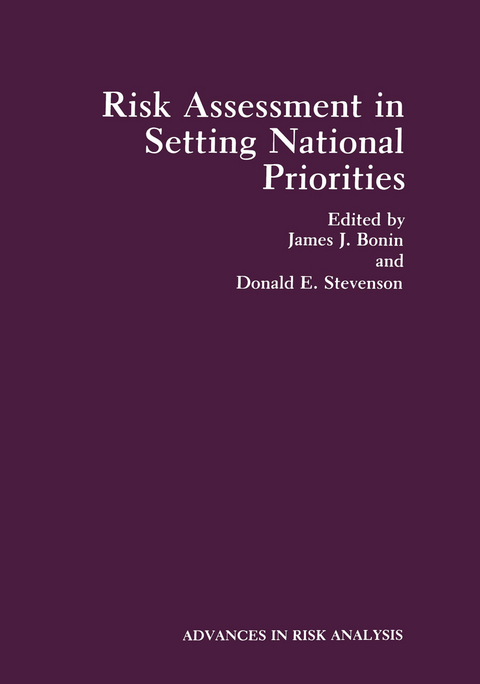
Risk Assessment in Setting National Priorities
Springer-Verlag New York Inc.
978-1-4684-5684-4 (ISBN)
Science and Sociology: The Transition to a Post-Conservative Risk Assessment Era.- The Use of Focus Groups in Risk Communication.- Development of Cleanup Criteria for the Port Hope Remedial Program.- Combining Physiology, Carcinogenic Mechanism, and Interindividual Variation in Cancer Dose-Response Extrapolations.- On Basing Extrapolation of Risk for a Chemical Carcinogen on Total Dose (Constant Dose Rate × Continuous Exposure Duration): Implications and an Extension.- The Approach to Risk Analysis in Three Industries: Nuclear Power, Space Systems, and Chemical Process.- An Epidemiologic Approach to Dealing with Multimedia Exposure to Multiple Related Chemicals.- Incorporating Risk into the Development of Soil Cleanup Guidelines for Trace Organic Compounds.- Quantifying and Comparing the Benefits of Risk Reduction Programs to Prioritize Expenditures.- Assessment of Risk from Short-Term Exposures.- Societal Risk from a Thermodynamic Perspective.- Risk in Defense Policy Decisions.- The Strategic Defense Initiative and Nuclear Proliferation from a Risk Analysis Perspective.- The Hazardous Air Pollutant Prioritization System.- Air Emission Risk Assessment Sensitivity Analysis for a Coal-Fired Power Plant.- A Systematic Approach for Environmental Risk Assessment.- The Use of Risk Index Systems to Evaluate Risk.- Probabilistic Seismic Risk to Non-Nuclear Facilities.- Catastrophic Damage from Dam-Break Floods.- Risk Reduction Strategies for Setting Remedial Priorities: Hazardous Waste.- Educating the Public About Toxicological Risk.- Upper-Bound Estimates of Carcinogenic Risk: More Policy Than Science.- Risk Communication: The Need for Incentives.- An International Approach to Health, Safety and Environmental Risk Management for a Diversified Corporation.- Risk Perception ofTechnologies: The Perspective of Similar Groups in Portugal and the United States.- Policy Lessons from Risk Communications Practice.- History of the Impurities Policy: Risk Assessment for Food and Color Additives.- Establishing a Threshold of Regulation.- The Use of Pharmacokinetics in Food Safety Evaluation.- Consideration of Cell Proliferation and Adduct Formation as Parameters Affecting Risk Outcome.- Global Risk Assessment.- Cost Benefit and Environmental Risk Aspects in the Context of European Air Pollution Control Strategies.- Health Effects of Occupational Exposures of Welders: Multicenter Study Using a Uniform Core Protocol.- Comparative Risk Assessment of Transportation of Hazardous Materials in Urban Areas.- Drinking-Age Laws: An Evaluation Synthesis of Their Impact on Highway Safety.- Fatality Incidence Stratified by Driver Behavior: An Exploratory Analysis with FARS Data.- An Assessment of the Risks of Stratospheric Modification.- Quality Assurance in Risk Models for Regulatory Decision Making.- Risk Assessment Issues in Implementing Emergency Planning and Community Right-to-Know Legislation.- System Unavailability Monitoring Study.- The Influence of the Climate of Risk Perception on the Process of Risk Management: Quantification, Evaluation, Decision Making.- The Nation-State in Societal Evaluation of Risk: Ambiguity Meets Reality.- Setting Risk Priorities in Environmental Policy: The Role of Women.- Comparison of Tumor Incidence for Short-Term and Lifetime Exposure.- Benzene and Leukemia: What Are the Risks and What Do the Data Reveal?.- Analysis of Individual Risk Belief Structures.- Sources of Common Cause Failures in Decision Making Involved in Man-Made Catastrophes.- Game Strategic Behavior Under Conditions of Risk and Uncertainty.- Conventional Wisdom on Risk Communication and Evidence from a Field Experiment.- Managing Uncertain Risks Through ‘Intelligent’ Classification: A Combined Artificial Intelligence/Decision-Analytic Approach.- Managing Fire Safety Problems Through Decision Analysis to Evaluate Fire Safety Hazards.- Can Risk Assessment and Risk Prioritization Be Extricated from Risk Management?.- Application of Risk Assessment Principles in Environmental Epidemiology.- A Comparison of the Remedial Priorities Determined Using More Likely Case and Worst Case Risk Estimates.- Cancer Incidence Among Welders Due to Combined Exposures to Elf and Welding Fumes: A Study in Data Pooling.- Role of Risk Assessment in New Hampshire State Government.- A Method for Estimation of Fish Contamination from Dioxins and Furans Emitted by Resource Recovery Facilities.- The Importance of the Hazard Identification Phase of Health Risk Assessments: Illustrated with Antimony Emissions from Waste Incineration Facilities.- The Utility of a National Food Survey in Assessing Dietary Risk and Exposure.- The Carcinogenic Risk of Some Organic Vapors Indoors: A Theoretical Survey.- Risk Assessment and National Standards: Philosophical Problems Arising from the Normalization of Risk.- The Use of Pharmacokinetic Models in the Determination of Risks for Regulatory Purposes.- Ethylene Oxide Residues on Sterilized Medical Devices.- Tetrachloroethylene Metabolism Resulting from Domestic Respiratory Exposure: Pharmacokinetic Considerations Relevant to Risk Assessment.- The Role of Speciation and Pharmacokinetics in Risk Assessment.- Assessing Risks of Cholinesterase-Inhibiting Pesticides.- Nuclear Power Safety Goals in Light of the Chernobyl Accident.- PRA-Based Inspection for Oconee Unit 3.- Environmental Radiation Standards and RiskLimitation.- The Anatomy of Safety Evaluations.- The Impact of Non-Drinking Water Exposures on Drinking Water Standards: A Problem of Acceptable Levels of Risk.- Estimating Exposures and Health Risks for Alternative Ozone National Ambient Air Quality Standards.- The Definition of Risk and Associated Terminology for Risk Analysis.- Author Index.
| Reihe/Serie | Advances in Risk Analysis ; 7 |
|---|---|
| Zusatzinfo | 698 p. |
| Verlagsort | New York, NY |
| Sprache | englisch |
| Maße | 178 x 254 mm |
| Themenwelt | Sachbuch/Ratgeber ► Natur / Technik ► Garten |
| Mathematik / Informatik ► Mathematik | |
| Studium ► Querschnittsbereiche ► Epidemiologie / Med. Biometrie | |
| Studium ► Querschnittsbereiche ► Prävention / Gesundheitsförderung | |
| Naturwissenschaften ► Biologie ► Ökologie / Naturschutz | |
| Technik ► Umwelttechnik / Biotechnologie | |
| ISBN-10 | 1-4684-5684-9 / 1468456849 |
| ISBN-13 | 978-1-4684-5684-4 / 9781468456844 |
| Zustand | Neuware |
| Haben Sie eine Frage zum Produkt? |
aus dem Bereich


